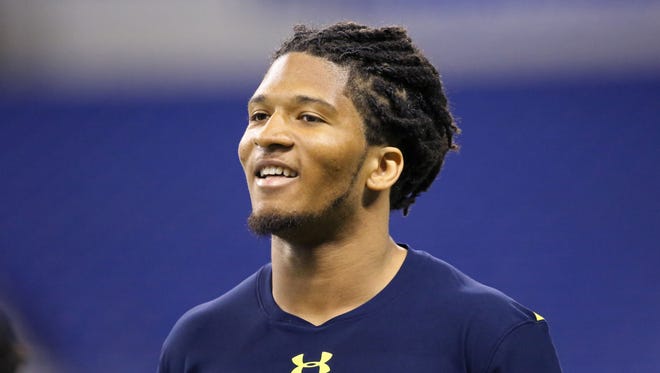Sidney Jones: I'm best cornerback in NFL draft despite Achilles injury

Hours after undergoing surgery to repair the Achilles tendon that ruptured at the University of Washington’s pro day and threw his NFL draft stock into doubt, Sidney Jones said he’s certain he’ll play in 2017 — and play like the first-round pick he believes he still deserves to be.
“I’m the best corner in the draft, plain and simple,” Jones told USA TODAY Sports by phone Tuesday, making the pitch he’ll take to NFL general managers and coaches in the coming weeks.
“Don’t look at the possibility of me not playing this first year. Me being injured for this short amount of time — it’s not going to compare to the rest of the contract, because any player can get hurt throughout their contract. This just happened to happen right now, and I can play basically right when the season starts.
“I will be playing this season. If you take me, I’m a good investment for your team. A great investment.”
MORE COVERAGE:
President Trump has ideas, but why is Colin Kaepernick still a free agent?
NFL mock draft 3.0: Who's rising after combine?
Jones’ availability as a rookie is a key point as NFL teams — each with its own approach to injury management, risk tolerance and need for immediate impact from its top picks — determine how high they’re willing to draft him. He’s a top prospect at a premium position who was a probable first-round pick before he got hurt March 11, but any team that decides a player needs a medical “redshirt” year is bound to drop him on the board.
Renowned orthopedic surgeon Robert Anderson, who performed Jones’ surgery Tuesday, stressed it’s impossible to predict a timeline for a player’s return to peak effectiveness, but “we can certainly anticipate (Jones) having the potential to be back on the field this year.”
The average time required for return to play from this type of injury is about six months, Anderson said, which for Jones would mean September.
Jones said he heard a clearer message: “The doctor told me I should be right on schedule to play at the beginning of the season and I will definitely be playing this year.”
Missing his entire first offseason won't help Jones’ development, but other players have been drafted high coming off major injuries. And Jones has other factors working in his favor. He suffered a “classic” (midsubstance) Achilles tendon rupture higher up on the tendon than an insertional rupture, which would take longer to heal, Anderson said. A modern surgical technique (mini-open repair) has shown lower risk for complications and a trend toward faster return to play, as documented in a paper by Kirk McCullough a few years ago. (Anderson was listed as a senior author.) Jones’ procedure required just three stitches.
Success stories of Baltimore Ravens linebacker Terrell Suggs (who returned from the first of two Achilles tears in a little over five months), Miami Dolphins defensive end Cameron Wake and others in recent years also cut against one much-discussed study, based heavily on media reporting, that the injury can have a significant impact on an NFL player’s career, or even end it.
“We’re doing studies with the NFL database now showing that’s not the case,” Anderson said. “And just anecdotally, I’ve never had a guy not come back who wanted to. As far as the performance levels, we’re looking into that now. That’s difficult to fully define. But again, we have not seen that anecdotally.
“Terrell Suggs, (former Baltimore Ravens wide receiver) Steve Smith, (Denver Broncos wide receiver) Demaryius Thomas, all the guys that had it have done very well. If they put the time and effort into it and avoid any complications obviously, I think people can do very well. It’s just the time.”
When he’s healthy, Jones is a valued commodity: a true cover corner, good in press and man, who’s also tough against the run for his size. He’d been making progress with filling out his 6-foot frame and weighed in at 186 pounds at February’s NFL scouting combine.
Jones took out a loss-of-value policy that would pay him if he slips out of the first round, according to one of his agents, Doug Hendrickson of ISE Football. But Hendrickson said he has spoken with almost every team since the injury and “we do not anticipate needing the (policy), because we certainly know he’ll still be a Round 1 guy somewhere.”
Video of the injury showed Jones go down untouched during a coverage drill. He initially looked around, thinking a football hit his heel, but didn’t see one. “I was like, ‘That’s bad,’” he said.
Jones admits it shook him up — the worst injury he’s ever had at a bad time — but he gained confidence once he researched others’ recovery. He’ll be off his feet for a few weeks while the tendon heals, then “attack this rehab like never before,” he said.
“I don’t think it’s going to affect me — not a touch,” Jones said. “They say once you injure this thing, it’s very unlikely you’ll injure it again and you’ll come back a lot stronger, a lot more explosive. This injury — I feel like it’s nothing to worry about.”
***
Follow Tom Pelissero on Twitter @TomPelissero
PHOTOS: NFL draft prospects at pro days
